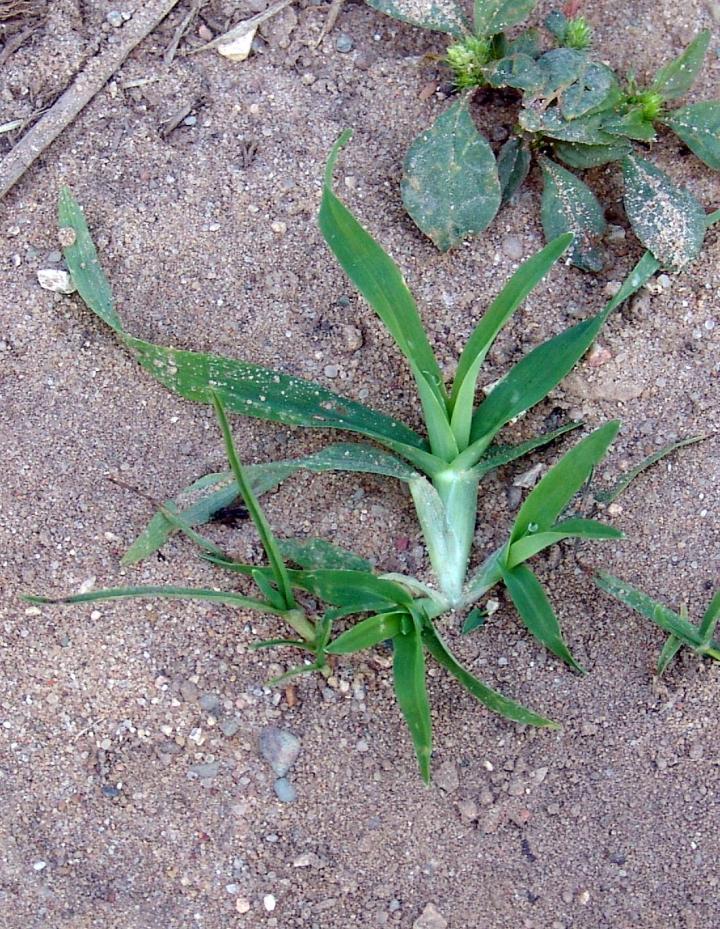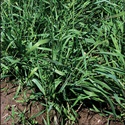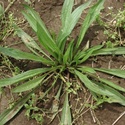






Crabgrass is a bothersome weeds on countless American properties.
Michigan State UniversityIt is very important to be able to tell weeds apart from your beautiful flowers, if only because you need to get rid of them! Part of growing your own garden means that you will also be growing weeds at some point. Below is a list of common weeds and their descriptions so that you can identify the intruders in your garden. And note that some weeds (such as lamb’s quarters, amaranth, and purslane) are edible—though only when young and tender. See our post, “Eating Weeds: Why Not?”
 Crabgrass tops America’s list of lawn complaints. A fast-growing annual that reproduces by seeds and by rooting at the lower joints. This weed appears from mid-spring through summer when the ground is warm. It grows well under dry, hot conditions. Go after crabgrass as soon as it appears in the garden. Dig it out by the roots with a spading fork or cover it with black plastic. Don’t let it go to seed.
Crabgrass tops America’s list of lawn complaints. A fast-growing annual that reproduces by seeds and by rooting at the lower joints. This weed appears from mid-spring through summer when the ground is warm. It grows well under dry, hot conditions. Go after crabgrass as soon as it appears in the garden. Dig it out by the roots with a spading fork or cover it with black plastic. Don’t let it go to seed.
To prevent crabgrass in the future, attack the problem in two stages. In the early spring, apply corn gluten meal, an organic preemergent herbicide. Spring is when the soil is cold and the crabgrass is weakest. (Crabgrass is an annual weed, so it starts from seed every year. The preemergent herbicide prevents the seed from germinating–and if the seed can’t sprout, it can’t grow.) Second, re-seed your lawn in the fall. This will allow the new grass time to grow strong before the next summer’s attack.
The best crabgrass preventer is a healthy, thick lawn, and soil with the proper pH balance (7.0-7.5). Perennial ryegrass is the best competition for crabgrass. It also provides some insect control, as it emits a natural poison that gives some small, damaging bugs the “flu.” Fertilizing is key and must be done in the spring and in the fall. Crabgrass thrives in compacted lawns. Aeration can help. A mixture of 1 pint of hydrogen peroxide, diluted to 3 percent, per 100 square feet of lawn can help eradicate the pesky plant. Click image to enlarge.
 An annual that reproduces by seeds. It is characterized by its fleshly, red taproot. This weeds appears in late spring or early summer and likes warm weather. Try to pull out this weed before it flowers.
An annual that reproduces by seeds. It is characterized by its fleshly, red taproot. This weeds appears in late spring or early summer and likes warm weather. Try to pull out this weed before it flowers.
To prevent weeds in the future, cover your garden plot with a winter mulch, then till the garden shallowly in early spring. When you till you may bring up some pigweed seed so it’s best to mulch again. Cover the soil with five layers of wet newspaper and cover that with 3-6 inches of mulch.
Pigweed can also be eaten! In June, the young leaves of amaranthus blitum or amaranth are abundant and should be eaten because of their high nutritional content. Vitamin-wise, these greens are packed like carrots and beets and can be delicious in a tossed salad. You can also cook them as you would spinach. Native Americans used the black seeds of this plant as a ground meal for baking. Click image to see more.
 There are two species of chickweed, one perennial and one annual. Mouse-ear chickweed is the perennial, which forms a dense, prostrate patch in lawns and gardens. Common chickweed, the annual, is more delicate in appearance, with leaves that are broad at the base and about half an inch long.
There are two species of chickweed, one perennial and one annual. Mouse-ear chickweed is the perennial, which forms a dense, prostrate patch in lawns and gardens. Common chickweed, the annual, is more delicate in appearance, with leaves that are broad at the base and about half an inch long.
Common chickweed is easier to control. Both types have shallow roots, so they can often be removed by hoeing or hand-pulling. New plants can grow from broken pieces of mouse-ear rootstock, however, so make sure you remove the entire plant when using either method.
A healthy lawn can compete against mouse-ear chickweed if the grass is not mowed too short or too frequently. Watering the lawn deeply and infrequently will encourage the grass to grow deeper roots, which also can help it compete against chickweed. Water once every seven to ten days, and apply enough water so that it soaks six to eight inches into the ground.
If you choose to remove chickweed, do it before the weed has time to go to seed, thereby preventing future problems in your garden area. Click image to expand.
 A common annual that reproduces by seeds and by deep, horizontal roots. This flowering vine sprouts in late spring and can be seen throughout the summer. This plant can become a big problem in warm weather. Try to dig out this weed before it flowers. Click image to see more.
A common annual that reproduces by seeds and by deep, horizontal roots. This flowering vine sprouts in late spring and can be seen throughout the summer. This plant can become a big problem in warm weather. Try to dig out this weed before it flowers. Click image to see more.
 A creeping, persistent perennial that reproduces by seeds. Its long, jointed, straw-colored rhizomes form a heavy mat in soil, from which new shoots may also appear. Try to dig out this weed as soon as you see it in your garden. Click image to enlarge.
A creeping, persistent perennial that reproduces by seeds. Its long, jointed, straw-colored rhizomes form a heavy mat in soil, from which new shoots may also appear. Try to dig out this weed as soon as you see it in your garden. Click image to enlarge.
 A fast-growing annual that reproduces by seeds. This summer weed rapidly removes moisture from soil, so remove it as soon as possible. Cultivate this weed out of your garden using a sharp hoe. Click image to see more.
A fast-growing annual that reproduces by seeds. This summer weed rapidly removes moisture from soil, so remove it as soon as possible. Cultivate this weed out of your garden using a sharp hoe. Click image to see more.
 An annual that reproduces by tiny black seeds and stem fragments. This weed appears in late spring or early summer and likes warm weather and rich, fertile soil. Pull or cultivate out this weed as soon as you see it and destroy the plant; this weed can live in your soil for years. Click image for a closer look.
An annual that reproduces by tiny black seeds and stem fragments. This weed appears in late spring or early summer and likes warm weather and rich, fertile soil. Pull or cultivate out this weed as soon as you see it and destroy the plant; this weed can live in your soil for years. Click image for a closer look.
Some purslane is edible! See gardening post.
 A flowering annual that reproduces by seeds. It likes cool weather and its yellowish-brown seeds are long-lived in the ground. Try to pull out this weed before it seeds. Click image for a closer look.
A flowering annual that reproduces by seeds. It likes cool weather and its yellowish-brown seeds are long-lived in the ground. Try to pull out this weed before it seeds. Click image for a closer look.
 A hardy perennial that reproduces by seeds. This narrow-leaved weed invades meadows, pastures, and lawns. This weed appears in any season. Hand weed this plant and destroy it to remove it from your garden. Click image to enlarge.
A hardy perennial that reproduces by seeds. This narrow-leaved weed invades meadows, pastures, and lawns. This weed appears in any season. Hand weed this plant and destroy it to remove it from your garden. Click image to enlarge.
Copyright © www.100flowers.win Botanic Garden All Rights Reserved